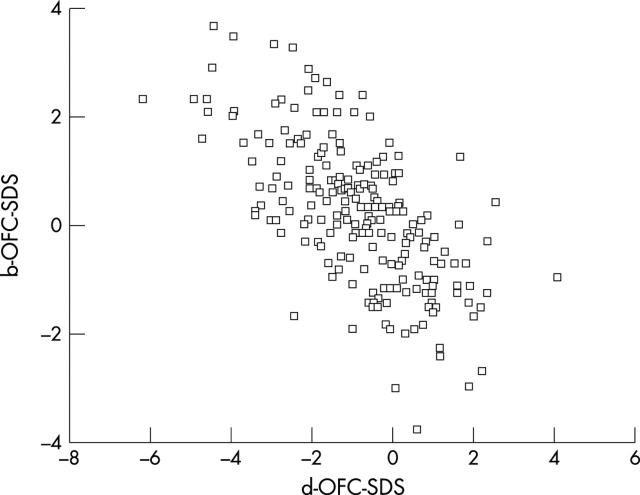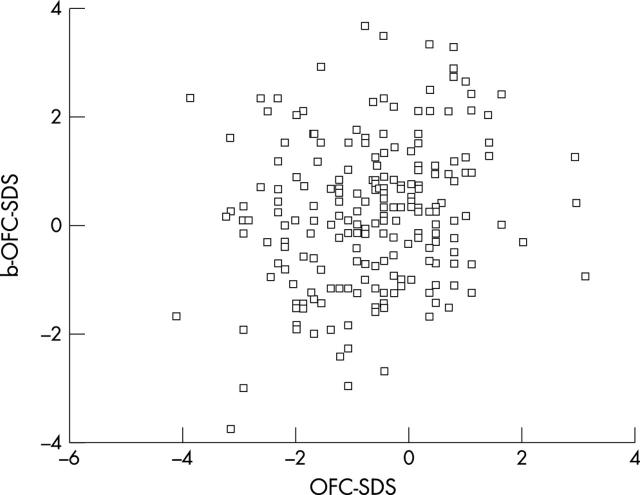Abstract
Background: Infants born of low birth weight often have poor subsequent growth (especially if they were born very preterm), which has been shown to relate to later motor and cognitive development.
Aims: To assess a cohort of preterm infants at the age of 7 years for growth, motor, and cognitive measures, and investigate the effects of growth impairment on school performance.
Methods: A cohort of 280 children born before 32 completed weeks of gestation were tested, together with 210 term controls.
Results: Pretem children were significantly lighter and shorter than term controls and had smaller heads and lower body mass index (BMI). Median centiles for weight, height, head circumference, and BMI were 25, 25, 9, and 50 for boys and 50, 25, 9, and 50 for girls compared with 50, 50, 50, and 75 for controls. They performed significantly less well on all tests with a mean score of 91 (9.2) on the Developmental Test of Visual-Motor Integration, 89 (14.5) on the Wechsler-III IQ test, and 30.7% scoring at or below the 5th centile on the Movement Assessment Battery for Children. In boys, short stature and small heads were the best predictors of poor performance; in girls, a small head alone was a predictor for poor motor and cognitive performance.
Conclusion: Poor postnatal growth in preterm infants, especially of the head, is associated with increased levels of motor and cognitive impairment at 7 years of age. This growth restriction appears to occur largely in the postnatal rather than antenatal period and may be amenable to intervention and subsequent improvement in outcome.
Full Text
The Full Text of this article is available as a PDF (134.0 KB).
Figure 1.
Graph of SDS for head circumference at birth (b-OFC-SDS) against change in SDS between birth and seven years (d-OFC-SDS), showing that those with the greatest loss in relative head circumference were not those most growth restricted at birth.
Figure 2.
Graph of SDS for head circumference at birth (b-OFC-SDS) against SDS for head circumference at seven years (OFC-SDS), showing that most of the preterm infants now growth restricted were not so at birth.
Selected References
These references are in PubMed. This may not be the complete list of references from this article.
- Berry M. A., Abrahamowicz M., Usher R. H. Factors associated with growth of extremely premature infants during initial hospitalization. Pediatrics. 1997 Oct;100(4):640–646. [PubMed] [Google Scholar]
- Bucher Hans Ulrich, Killer Christa, Ochsner Yvonne, Vaihinger Svantje, Fauchère Jean-Claude. Growth, developmental milestones and health problems in the first 2 years in very preterm infants compared with term infants: a population based study. Eur J Pediatr. 2002 Mar;161(3):151–156. doi: 10.1007/s00431-001-0898-0. [DOI] [PubMed] [Google Scholar]
- Cooke R. W. Trends in incidence of cranial ultrasound lesions and cerebral palsy in very low birthweight infants 1982-93. Arch Dis Child Fetal Neonatal Ed. 1999 Mar;80(2):F115–F117. doi: 10.1136/fn.80.2.f115. [DOI] [PMC free article] [PubMed] [Google Scholar]
- Dobbing J., Sands J. Comparative aspects of the brain growth spurt. Early Hum Dev. 1979 Mar;3(1):79–83. doi: 10.1016/0378-3782(79)90022-7. [DOI] [PubMed] [Google Scholar]
- Embleton N. E., Pang N., Cooke R. J. Postnatal malnutrition and growth retardation: an inevitable consequence of current recommendations in preterm infants? Pediatrics. 2001 Feb;107(2):270–273. doi: 10.1542/peds.107.2.270. [DOI] [PubMed] [Google Scholar]
- Gutbrod T., Wolke D., Soehne B., Ohrt B., Riegel K. Effects of gestation and birth weight on the growth and development of very low birthweight small for gestational age infants: a matched group comparison. Arch Dis Child Fetal Neonatal Ed. 2000 May;82(3):F208–F214. doi: 10.1136/fn.82.3.F208. [DOI] [PMC free article] [PubMed] [Google Scholar]
- Hack M., Breslau N., Weissman B., Aram D., Klein N., Borawski E. Effect of very low birth weight and subnormal head size on cognitive abilities at school age. N Engl J Med. 1991 Jul 25;325(4):231–237. doi: 10.1056/NEJM199107253250403. [DOI] [PubMed] [Google Scholar]
- Hack M., Taylor H. G. Perinatal brain injury in preterm infants and later neurobehavioral function. JAMA. 2000 Oct 18;284(15):1973–1974. doi: 10.1001/jama.284.15.1973. [DOI] [PubMed] [Google Scholar]
- Hirata T., Bosque E. When they grow up: the growth of extremely low birth weight (< or = 1000 gm) infants at adolescence. J Pediatr. 1998 Jun;132(6):1033–1035. doi: 10.1016/s0022-3476(98)70404-4. [DOI] [PubMed] [Google Scholar]
- Kitchen W. H., Doyle L. W., Ford G. W., Callanan C., Rickards A. L., Kelly E. Very low birth weight and growth to age 8 years. II: Head dimensions and intelligence. Am J Dis Child. 1992 Jan;146(1):46–50. doi: 10.1001/archpedi.1992.02160130048020. [DOI] [PubMed] [Google Scholar]
- Murphy B. P., Inder T. E., Huppi P. S., Warfield S., Zientara G. P., Kikinis R., Jolesz F. A., Volpe J. J. Impaired cerebral cortical gray matter growth after treatment with dexamethasone for neonatal chronic lung disease. Pediatrics. 2001 Feb;107(2):217–221. doi: 10.1542/peds.107.2.217. [DOI] [PubMed] [Google Scholar]
- Powls A., Botting N., Cooke R. W., Pilling D., Marlow N. Growth impairment in very low birthweight children at 12 years: correlation with perinatal and outcome variables. Arch Dis Child Fetal Neonatal Ed. 1996 Nov;75(3):F152–F157. doi: 10.1136/fn.75.3.f152. [DOI] [PMC free article] [PubMed] [Google Scholar]
- Robertson C. M., Etches P. C., Goldson E., Kyle J. M. Eight-year school performance, neurodevelopmental, and growth outcome of neonates with bronchopulmonary dysplasia: a comparative study. Pediatrics. 1992 Mar;89(3):365–372. [PubMed] [Google Scholar]
- Rogers B., Andrus J., Msall M. E., Arvedson J., Sim J., Rossi T., Martin D., Hudak M. Growth of preterm infants with cystic periventricular leukomalacia. Dev Med Child Neurol. 1998 Sep;40(9):580–586. doi: 10.1111/j.1469-8749.1998.tb15422.x. [DOI] [PubMed] [Google Scholar]
- Sonntag J., Grimmer I., Scholz T., Metze B., Wit J., Obladen M. Growth and neurodevelopmental outcome of very low birthweight infants with necrotizing enterocolitis. Acta Paediatr. 2000 May;89(5):528–532. doi: 10.1080/080352500750027790. [DOI] [PubMed] [Google Scholar]
- Stathis S. L., O'Callaghan M., Harvey J., Rogers Y. Head circumference in ELBW babies is associated with learning difficulties and cognition but not ADHD in the school-aged child. Dev Med Child Neurol. 1999 Jun;41(6):375–380. doi: 10.1017/s0012162299000833. [DOI] [PubMed] [Google Scholar]




